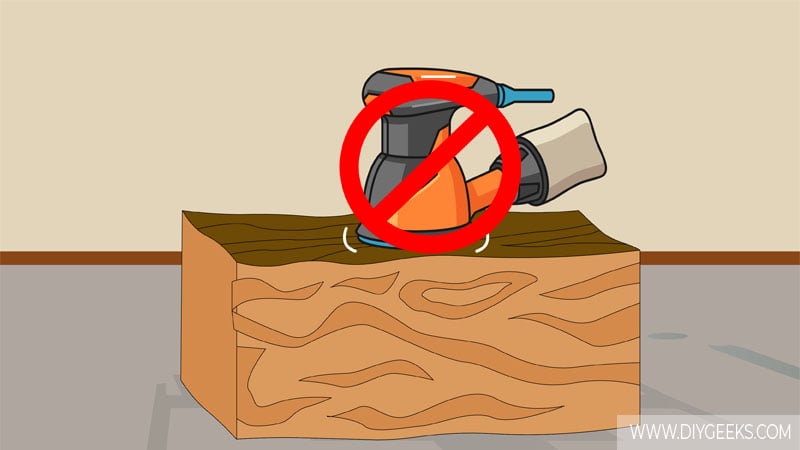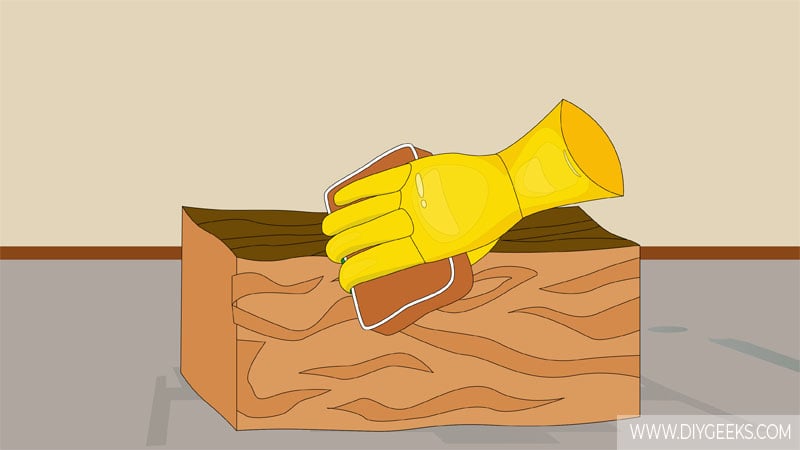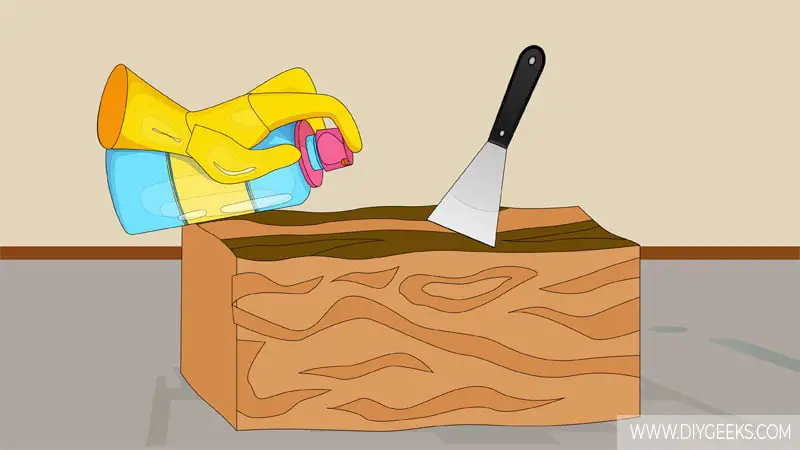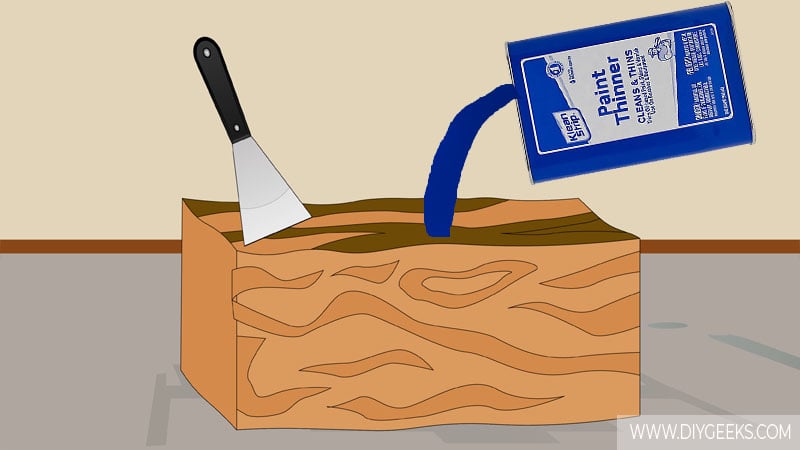Wood stain penetrates the wood pores (or grain) deeply when applied, so it’s hard to remove it.
To remove wood stains from wood, use sandpaper, a wood stain remover, or paint thinner. You can re-stain the surface within 30 minutes if you remove the old coating using sandpaper.
Sanding is the best way to remove it as it also preps the surface by removing imperfections and making it ready for the next finish. Wood stain stripper is also effective, but it doesn’t remove imperfections or smooth out the surface.
Can You Remove Wood Stain From Wood Without Sanding?

You can remove wood stains from wood without sanding by using a paint-stripping product.
A paint stripper is a solvent-based product that penetrates the wood grain (or pores) and dissolves the particles of the stain. Once the particles are dissolved, the coating will liquefy and peel off.
But, sanding is the best way to remove wood stain because it will also smooth the surface, remove imperfections, and make the surface ready for painting at the same time.
On the other hand, a paint stripper doesn’t smooth the surface, remove imperfections, or make the surface ready for paint. The plastic scraper (that you use to scrape the stain off) will damage the wood surface. So, after using a paint stripper, you must sand lightly sand the surface anyway.
Also, some solvent-based removers can discolor or damage particular wood types.
How To Remove Wood Stain From Wood?
To remove wood stain from wood, do the following things.
- Sand it off.
- Use a Wood Stain Remover.
- Use Paint thinner.
- Use Acetone.
- Apply Paint Remover.
- Use Vinegar.
- Power Washing.
- Use Citristrip
- Use Mineral Spirits.
1. Use a Sandpaper

Medium-grit sandpaper (100-grit) can remove wood stain from wood without damaging or affecting the underlying surface. The sandpaper gradually wears off the finish from the surface until it’s removed.
The tools you need for this project are listed below.
- Sandpaper
- A duster or vacuum
- Orbital sander (for large wooden surfaces and floors)
Here’s a step-by-step guide:
- Clean the surface to remove dust and dirt. For floors, use a vacuum and mop the floor.
- Use medium-grit sandpaper (100-grit) to sand the wooden surface. For large surfaces, use a power sander.
- Sand the surface repeatedly until the wood stain is removed.
- Remove the dust and let the wood settle.
Use coarse-grit sandpaper (40-grit) if the stained wood is sealed or hard to remove.
2. Use a Wood Stain Remover

Wood stain removers are products designed to remove wood stains from different surfaces. They penetrate the stain coating, break the bond between binders, and liquefy the coating, making scraping and wiping it easier.
The tools you need for this project are listed below.
- Paint stripper
- Paint scraper
- Clean rags
- Paintbrushes
- Plastic bag
Step-by-step guide:
- Clean the surface to remove dirt and debris.
- Apply wood stain remover over the wooden surface with a paintbrush.
- Wait around 20 minutes.
- Once the finish starts to bubble, use a paint scraper to remove it.
- Clean the wood with soapy water and allow it to dry.
3. Use Paint thinner

Paint thinners are liquid-based products designed to thin and remove different paint and wood stain types from surfaces.
The tools you need for this method are listed below.
- Paint thinner
- A pair of gloves
- Clean bucket
- Paint scraper
- Microfiber cloth
- Mineral spirits
- A clean rag
Here’s a step-by-step guide:
- Clean the surface with a dampened.
- Damp a rag with paint thinner.
- Wipe the stained wood with the dampened rag.
- Wait around 15 minutes.
- Use a scrubbing brush to scrub wood stains off.
- Use mineral spirits to clean the wooden surface and remove the paint-thinner residue.
- Pour soapy water over the surface.
- Allow the wood to dry.
4. Use Acetone
Acetone is a natural paint remover that can remove wood stains from different surfaces. However, acetone can’t penetrate surface pores too deep, so it can’t remove the finish completely.
5. Use Paint Remover
Paint removers are products designed to remove different paint and wood stain types from different surfaces. Ensure to use a paint remover designed for wooden surfaces.
6. Use Vinegar
You can use vinegar to remove wood stains. Simply damp a rag with vinegar, use the rag to wipe the stained wood, wait around 10 minutes, and use a paint scraper to scrape the finish off.
7. Power Washing
You can use a power washer to wash off wood stains from various surfaces.
8. Use Citristrip
Citristip is an industrial cleaning solvent that removes different wood finishes.
9. Use Mineral Spirits
You can use mineral spirits to remove the wood stain top layer from the surface, but not the whole finish.
Which Products Can’t Remove Wood Stain?
The products that can’t remove wood stains are listed below.
1. White Spirits
You can’t use white spirits to remove wood stains as it’s a petroleum-based solvent designed for cleaning and grease removal.
2. Bleach
You can’t use bleach to remove wood stains as it can damage or discolor the wooden surface and make it unpainted.
How Long To Wait Before Re-staining Wood?
You must wait 12 hours before re-staining wood. This gives the surface enough time to dry and settle after using a solvent-based remover.
If you re-stain the surface too soon, the solvent residue on the surface will repel the new paint (or wood stain) and leave behind an amateurish finish.
You can re-stain wood within 30 minutes if you remove the wood stain by sanding. That’s because sanding doesn’t dampen the surface, removes imperfections, and makes it ready for the next paint.


